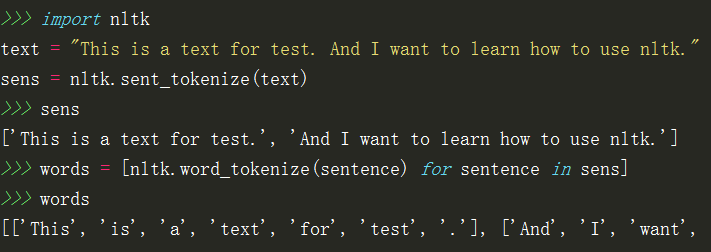热门标签
热门文章
- 1《算法导论》笔记 第24章 总结与思考_算法导论思考题24-3
- 2学习笔记——计算机网络(Internet、网络边缘)
- 3mybatis<selectKey>标签的作用_mybatis selectkey标签
- 4如何使用 idea 调试 skywalking_idea 调试skywalking agent
- 5AI大模型低成本快速定制法宝:RAG和向量数据库_ai rag
- 6Spring IOC的启动流程(Spring bean对象的创建过程),从理论到源码,一步分析到位_spring ioc启动过程
- 7Spring 获取带有指定注解的Bean对象_applicationcontext.getbeanswithannotation
- 8实战项目-Java实现自动贩卖机/售货机【完整版】_编写一个自动售货机的程序
- 9论文阅读笔记 | 三维目标检测——PV-RCNN算法_pvrcnn
- 10Human Perception of Visual Information (4)
当前位置: article > 正文
python nltk 基本操作_python nltk grammar
作者:不正经 | 2024-03-15 15:44:07
赞
踩
python nltk grammar
分词
nltk.sent_tokenize(text) #按句子分割
nltk.word_tokenize(sentence) #分词
nltk的分词是句子级别的,所以对于一篇文档首先要将文章按句子进行分割,然后句子进行分词:
词性标注
nltk.pos_tag(tokens) #对分词后的句子进行词性标注
tags = [nltk.pos_tag(tokens) for tokens in words]
>>>tags
[[('This', 'DT'), ('is', 'VBZ'), ('a', 'DT'), ('text', 'NN'), ('for', 'IN'), ('test', 'NN'), ('.', '.')], [('And', 'CC'), ('I', 'PRP'), ('want', 'VBP'), ('to', 'TO'), ('learn', 'VB'), ('how', 'WRB'), ('to', 'TO'), ('use', 'VB'), ('nltk', 'NN'), ('.', '.')]]
- 1
- 2
- 3
分块 Chunking
用于实体识别的基本技术是分块,可以理解为把对个token组成词组。
名词短语分块
NP-chunking,寻找单独名词短语对应的块。为了创建NP分块,首先需要定义分块语法,规定句子如何分块。下面使用的是一个简单的正则,这条规则规定由可选的且后面跟着任意数量形容词(JJ)的限定词(DJ)和名词(NN)组成。
>>> text = "the little yellow dog barked at the cat"
>>> sentence = nltk.word_tokenize(text)
>>> sentence = nltk.pos_tag(sentence)
>>> sentence
[('the', 'DT'), ('little', 'JJ'), ('yellow', 'NN'), ('dog', 'NN'), ('barked', 'VBD'), ('at', 'IN'), ('the', 'DT'), ('cat', 'NN')]
>>> grammar = "NP: {<DT>?<JJ>*<NN>}"
>>> cp = nltk.RegexpParser(grammar)
>>> result = cp.parse(sentence)
>>> result
Tree('S', [Tree('NP', [('the', 'DT'), ('little', 'JJ'), ('yellow', 'NN')]), Tree('NP', [('dog', 'NN')]), ('barked', 'VBD'), ('at', 'IN'), Tree('NP', [('the', 'DT'), ('cat', 'NN')])])
>>> result.draw()
- 1
- 2
- 3
- 4
- 5
- 6
- 7
- 8
- 9
- 10
- 11
命名实体识别
声明:本文内容由网友自发贡献,不代表【wpsshop博客】立场,版权归原作者所有,本站不承担相应法律责任。如您发现有侵权的内容,请联系我们。转载请注明出处:https://www.wpsshop.cn/w/不正经/article/detail/242567
推荐阅读
相关标签



